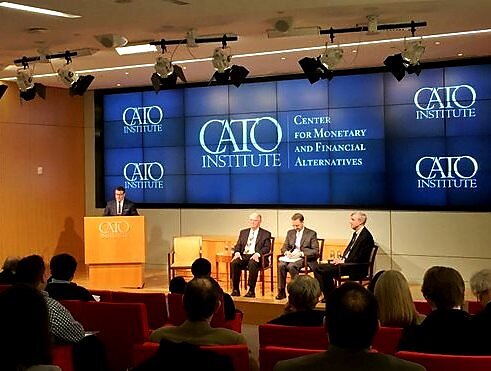Thornton kicked off the event by presenting his recent Cato Policy Analysis. According to Fed officials, QE would stimulate growth in two ways. First, there would be a “portfolio balance effect”: asset purchases would allow the Fed to reduce long-term interest rates even after short-term rates hit the zero lower bound. By pushing down term premiums of those assets, Fed purchases of Treasuries, agency mortgage-backed securities (MBS), and agency debt would also push down the yields of other, similar assets, stimulating investment.
Large scale asset purchases would also signal to investors a change in the long run path of short-term interest rates, since the central bank stands to lose if interest rates go up when the duration of its outstanding debt (because of QE) has shortened.
Thornton noted an inconsistency between the “signaling” and portfolio-balance channels. The portfolio balance channel only works assuming that markets for long and short term bonds are “segmented,” meaning that the bonds are not treated as substitutes, whereas the signaling channel assumes that those markets are not segmented. Thornton also claimed that there is no convincing statistical evidence that QE was actually effective. He noted, for example, that only in one case did a Fed announcement related to QE cause a statistically significant drop in long term yields. In some others, yields temporarily rose after a Fed announcement.
Although Joe Gagnon and Scott Sumner both disputed Thornton’s negative assessment of QE, opinions diverged from there. Gagnon was most supportive, while Sumner offered a heavily-qualified defense.
Gagnon worked as an associate director at the Federal Reserve from 1999–2009 where he was one of QE’s main architects. Since leaving the Fed he has written widely cited papers praising QE’s effect on financial markets and arguing the virtues of the Fed holding a large balance sheet, so his defense of QE was no surprise. Indeed, he in fact described himself as “perhaps the biggest cheerleader in the world for QE.”
According to Gagnon, while there was much debate when QE was first adopted over whether it would work, at central banks worldwide there is a strong consensus that QE has in fact proven to be a “potent monetary tool.”
Skepticism about QE expressed by non-monetary economists, the financial press, and the general public is mostly due, Gagnon argued, to the tepidness of the economic recovery. How could QE have worked well when the recovery has been slow and is even now incomplete? According to Gagnon, the empirical evidence shows that QE did in fact help, by pushing down real short term interest rates, though it failed to push them down as far as the ailing U.S. economy required.
Gagnon did not deny, however, that the low interest rates to which QE contributed hurt savers. He also agreed that purchasing Treasuries and MBS only is a form of preferential credit allocation, suggesting central banks should ideally buy a market representative basket of assets. Our own George Selgin, while not a fan of Fed asset purchases in principle, has argued that Fed OMO purchases of a wider array of private and public securities would be better than Treasuries only.
Although Sumner largely agreed with Gagnon about QE’s positive effects, he added that the Fed would not have had to use QE on such a large scale had the Fed resorted to it, instead of limiting itself to sterilized emergency lending, at an earlier stage of the crisis. The Fed’s decision to pay interest on bank reserves, he said, also limited QE’s effectiveness.
Regarding empirical evidence of QE’s effects, Sumner argued that interest rate effects alone are not a reliable indicator. Although expansionary monetary policy tends to drive interest rates down, while contractionary monetary policy often pushes rates up, Sumner noted that rates can move in the opposite direction in the long run if the respective policies actually work, and that this long-run effect can translate into a short-run effect if it is expected to work. Sumner referred to some non-interest-rate evidence that QE was indeed effective, including a comparison of the progress of recovery in Europe, where QE was long resisted, with its progress in the U.S.
Sumner devoted much of his time to criticizing the Fed for putting itself in the position where it had to use QE in the first place. Had the Fed targeted spending in the lead up to the crisis monetary policy would not have been too tight, and the recession might never have happened.
The policy forum wrapped up with audience questions, though perhaps the highlight of that part of the forum was not a question from the public audience but rather a question asked by the moderator, George Selgin. Selgin noted that all studies showing QE’s effect on interest rates, including the prominent ones conducted by Gagnon, stop there, and do not address QE’s effect on “macroeconomic economic variables of ultimate concern,” like growth rates or unemployment.
Selgin’s question induced an interesting debate between Thornton and Gagnon. Gagnon argued that the interest rate evidence was sufficient documentation of QE’s real economic effects. Without being able to test counterfactuals, researchers could not measure QE’s direct impact on the job market or GDP growth. However, economists’ knowledge of the relationship between financial markets and the real economy is concrete enough to make the interest rate evidence convincing. Thornton did not doubt that financial indicators generally can serve as proof of real economic changes. Rather, he emphasized that while studies show a statistically significant effect of QE on interest rates, the effects amount to only a 10–38 basis point change in long-term Treasury yields. That such a small difference in rates could drive such big changes in the economy seemed inherently suspect to Thornton.
For the full discussion, listen to the podcast or watch the video.


